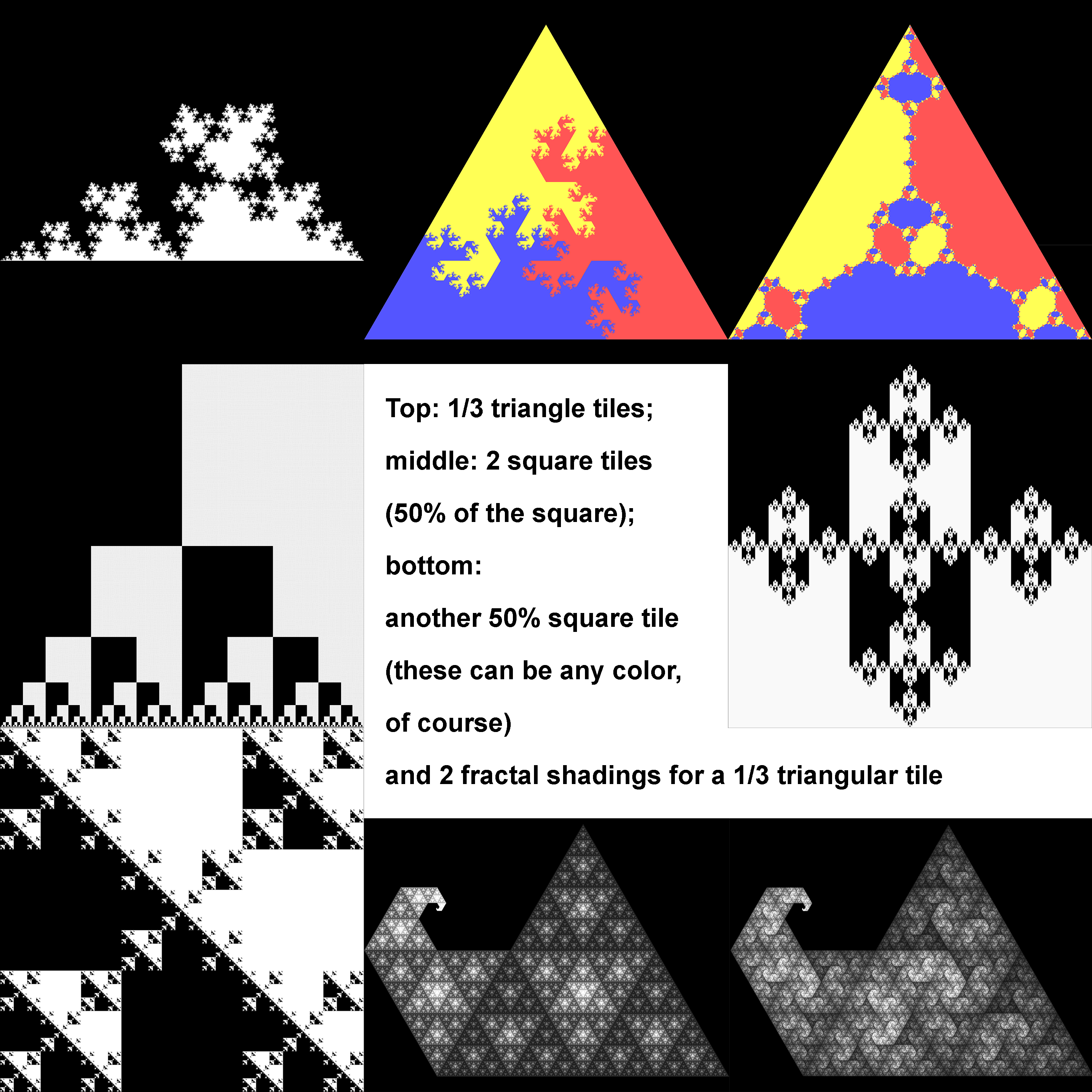Not about the Math, 2
BLOG
Still with me, dear reader, or joining for the first time? You’ll need to look at last week’s article for this one to make much sense, as this is part 2, the final part. Again, no formulas, just a few fractions. And more pictures, of course.
My tiles of the square can take up the following proportions of it: all (1: not really a tile), ½, ¼ or 1/8. The ¼ ones I consider to be the main type for the square, though all four types are infinite in number. This is because there are the same number of tiles required as the square has sides. The triangle’s versions can be one (also not really a tile), 1/3 or 1/6 of its space, with the 1/3 type my main one here, again related to the triangle’s number of sides. We won’t be getting further into tiles of the cube here, as square- and triangle-filling ones are enough of a subject in themselves, and this newspaper is also effectively 2D, making clear 3D tiling representations a challenge anyway.
A tile of these kinds has two parts, like its parent shape: exterior (edge) and interior (filling). The programming of each tile requires both parts to be used, in the correct amounts and proportions to each other, to result in a tile: no holes (too small) or overlaps (too large), remember!
Consider one side line of a square or triangle. This line can be divided into two or more equal pieces, as many as you like. The number of divisions is the SIZE of the shape. The shape’s interior can similarly be divided, based on its property of being a reptile, reducible into smaller copies of itself. (The interior line segments are all “double-sided” lines, each line segment being shared by exactly two of the reptile’s smaller shapes.) These divisions give us all the working material we need from which to construct our tiles. Each line segment must be used exactly once in the tile-making process.

The simplest kinds of tile have: 1) all line segments (interior and exterior) connected; 2) all their exterior line segments on one side of the shape; 3) all their interior line segments made up of double sided lines. Other types break one or more of these rules, but are also tiles. All can be beautiful or ugly or anywhere in between. And there IS a roughly common perception among different people of “more or less beautiful”, which is a profound admission.
If a square tile has all its interior and exterior lines parallel, then the resulting tile will fill ½, not ¼, of the square; there are infinitely many such tiles. If a triangle’s lines, on the other hand, are all parallel, its tile will fill 100% of the triangle. You might then conclude that there is only one of this triangle-filling shape, and in one sense you are right. However, the order in which its line segments are selected will affect the fractal pattern of its coloring, should we choose to color it based on this order and not just as a boring solid triangle. So here, too, is an infinity, though just of patterns in a triangle, not of tiles of it.
We need not go into 1/8 tiles of the square or 1/6 ones of the triangle here, as the ones described above are the most interesting, and they are all infinite, anyway. But there is another thing we should think about: no-one will ever exhaust the set of tiles of the square or triangle, to the end of time. I found over 6000 of them in a few years’ occasional work, using only squares and triangles up to size 6! (The larger the size of the parent shape, the more tiles can be found for it, although the formula for calculating the number of tiles based on size has eluded me so far. All the tiles for size 2 are duplicated in size 4, and 16, etc., along with many other new ones…) Infinities can be both thrilling and daunting, taking a finite human mind to the edge of madness if dwelt upon to the point of obsession. A tile for every person on the planet? As many per persons as you like, actually. The same for every atom in the universe! That’s what infinity means.
My tiles can be programmed using the simple L-systems or Iterated Function Systems (IFS) languages for generating fractals on a computer. They can, too, be drawn on squared or triangularly ruled paper. I mostly use the freeware program FractInt, originally in DOS but now available for non-DOS Windows, Apple and Linux too.
This concludes my introduction of what I call Hanmer Tiles, which I discovered in 2003. Any book showcasing them will only ever be an infinitely small part of the whole, no matter how many thousands or millions of pictures it contains. But that should not prevent such a book from being produced. For more examples online, please see https://www.behance.net/gallery/729496/Endless-Tiles-of-the-Equilateral-Triangle-and-Square
Tony Hanmer has lived in Georgia since 1999, in Svaneti since 2007, and been a weekly writer for GT since early 2011. He runs the “Svaneti Renaissance” Facebook group, now with over 1700 members, at www.facebook.com/groups/SvanetiRenaissance/
He and his wife also run their own guest house in Etseri:
www.facebook.com/hanmer.house.svaneti
Tony Hanmer












